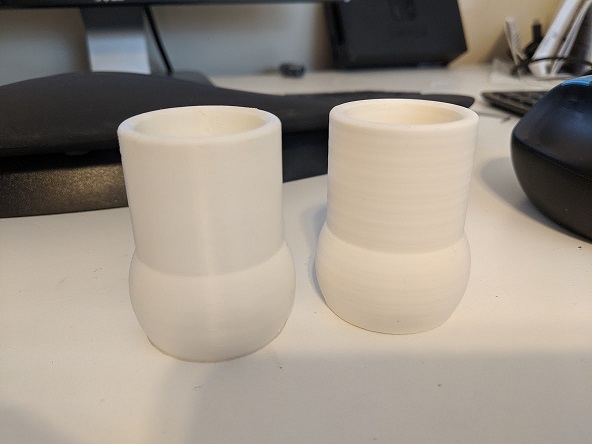Uneven layers
-
@deckingman here's a new test with a 50x50 cube and 0.6mm layer height. Same results.

-
how are your bearings on your z axis. do they move freely when you take off the lead screw? I had one of 4 of my bearings that was not as smooth at the others and it caused a similar issue.
-
And here's the same print with 0.3mm layer height.

-
@antlestxp Hi,
Yes they move very freely.
In my opinion it can't be any misalignment issue, as the indents/outdents goes all around the print (it's very clear on the 0.3mm picture) -
@haggan90 in my case the bearing would reduce bed movement every few mm causing the layers to squish until the bearing pushed through its "tight" spot
-
@haggan90 said in Uneven layers:
Does anyone have any other ideas?

I will try what @deckingman suggested and print a new larger cube without the X and Y imprints to see if the problem remains.Could this has to do with the 1066.67 steps/mm on the Z steppers?
Would it be better if I geared them down 1:3 to get an even 3200 steps/mm?
Or maybe remove the lead screws and add belts instead?measure the number of layers in the repeating pattern and then try a different layer height to see what impact it has. Those larger cubes without the X etc indentations make it easier to tie down the problem. It could be because you have non metric lead screws and the later heights don't add up to round numbers but if so this is pretty extreme banding for that.
-
@t3p3tony Tony,
We went through his lead screws and steps per mm etc in his other thread. His screws have a lead of 3mm which is unusual but means that one full step is 0.015mm. So providing he uses layer heights that are multiples of 0.015 then he should be using full steps and not relying on micro-stepping for positional accuracy. So 0.3mm layer height @1066.67 steps per mm @16X would be 320 micro steps or 20 full steps and 0.6mm layer height would equate to 40 full steps.
Even if the firmware rounds 1066.67 up to 1067 steps per mm then 0.3mm becomes 320.1 but you can't have 0.1 of a micro step so it would still send 320 (micro) steps. If the firmware keeps track of the fractional micro steps and adds one on when it gets to a full micro-step, then that would repeat at 3 mm but 1 micro-step is 1/10667 mm so that wouldn't be noticeable.
@Haggan90 Are you sure the lead of the screws is indeed 3mm and not say 1/8 inch? I only ask because 1/8 inch is 3.175 mm which might explain your banding if you set the steps per mm to 3mm. Clutching at straws here..........
-
@deckingman thanks, missed the other thread.
@Haggan90 worth trying the different layer height slices anyway, now you have the cubes printing well and seeing if the repeatability of the issue is the same or different.
-
@deckingman said in Uneven layers:
Are you sure the lead of the screws is indeed 3mm
in the link he posted its indeed 3mm lead. however his lead screw is also 800mm long!
can you post a picture of your printer?
-
@veti But did he get what he asked for and ordered? Why is the 800mm length relevant? Mine are 1,000mm.
-
at 800mm it would be easy to have one axis offset by a millimetre. that could cause binding of the lead screws.
the ingus nuts are very thight for those lead scews. -
This is how it looks right now.

-
@haggan90 If those screws are constrained at the top, try taking the upper mount off. The linear guides should be contstraining any XY movement, not the screws. So if you allow the top of the screws to "float" it will ensure that there are no binding issues.
-
@deckingman they are Only constraint at the top and not at bottom. I got a flec coupling on the steppers at the bottom.
-
@haggan90 said in Uneven layers:
@deckingman they are Only constraint at the top and not at bottom. I got a flec coupling on the steppers at the bottom.
Those flex couplings might be the cause of your problems, depending on what type they are. If you have any sort of binding on the bearings, some designs of the flex couplings can "wind up" absorbing some of the movement. Then a bit more tension is enough to overcome the binding and you get a sudden jump.
-
@deckingman That makes sense... because when I attach a precision gauge to the bed and move it down it only moves around 0.001mm-0.003 so it's sturdy. Would any sort of printed couplings work?
-
@deckingman I just tried to push the couplings together as hard as I could to see if it makes any diffrence, will be back with a photo!
-
@deckingman Dammit, made no diffrence at all =(
-
i just upgraded a back up printer I have to a maestro and that printer now shows the same banding. is there a possibility of a firmware issue with coarse threaded z rods. I use fine pitch rods on my primary printer and don't have the issue. or at least it isn't obvious on that printer. they are both hypercubes with the only difference being the pitch of the threaded rods.
this part was printed at .2 in petg with the latest fw
M350 X16 Y16 Z16 E16 I1
M92 X80.00 Y80.00 Z800.00 E407.16
-
8bit with octoprint vs maestro on the same printer. I will admit 2 different brands of abs and re-sliced to account for the different fw flavor.
